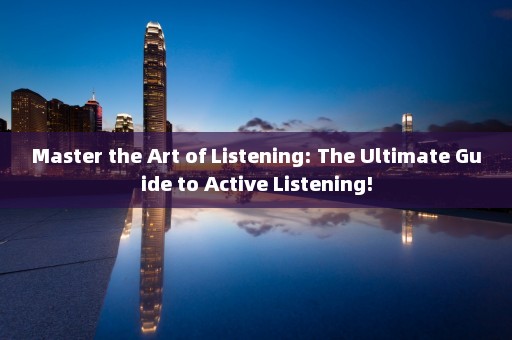Have you ever found yourself in a conversation where you zoned out, only to be snapped back to reality by the other person asking, "Are you even listening to me?" I'll admit, it's happened to me more times than I'd like to recall. But what if I told you that by mastering the art of active listening, you could transform your personal and professional relationships? Follow along as I share my journey to becoming an active listener and discover the ultimate guide to mastering this invaluable skill!

Understanding Active Listening
Active listening is not just hearing the words spoken to you; it's fully engaging with the speaker, understanding their message, and demonstrating empathy. According to a published in the International Journal of Listening, active listening can improve communication, foster understanding, and build stronger relationships.
My Personal Experience
Before I discovered the power of active listening, my relationships were lackluster at best. I would find myself interrupting others, formulating responses in my head instead of truly hearing what they were saying. It wasn't until a close friend confronted me about my listening habits that I realized the error of my ways. Since then, I've dedicated myself to mastering the art of active listening, and the results have been nothing short of remarkable.
Practical Instructions for Active Listening
1. Focus on the Speaker
When engaging in a conversation, give your full attention to the speaker. Maintain eye contact, avoid distractions, and resist the urge to check your phone or glance around the room. Show genuine interest in what they're saying by nodding, smiling, and using non-verbal cues that indicate you're fully present.
2. Listen to Understand, Not to Respond
One of the most common pitfalls in communication is listening only to form a response. Instead, focus on understanding the speaker's perspective. This means setting aside your own opinions and preconceived notions, allowing the speaker to express themselves fully without interruption.
3. Reflect and Paraphrase
After the speaker has shared their thoughts, summarize or paraphrase what you've heard to demonstrate your understanding. This technique not only clarifies any misunderstandings but also shows the speaker that you were actively listening. For example, you might say, "I understand that you're feeling overwhelmed by your workload. Is that correct?"
4. Ask Open-Ended Questions
Open-ended questions encourage the speaker to elaborate on their thoughts and feelings. This demonstrates your interest and encourages a deeper level of communication. For instance, instead of asking, "Do you like your job?" try asking, "What do you enjoy most about your job?"
5. Be Mindful of Non-Verbal Cues
Non-verbal communication plays a significant role in active listening. Ensure your body language is open and inviting. Avoid crossing your arms, rolling your eyes, or displaying any negative facial expressions. Instead, use gestures that indicate engagement and understanding, such as nodding, maintaining eye contact, and leaning slightly towards the speaker.
Necessary Precautions
While active listening is a valuable skill, there are a few precautions to keep in mind:
- Avoid interrupting the speaker, even if you think you know what they're going to say.
- Be mindful of your own biases and try not to jump to conclusions.
- Respect the speaker's privacy and confidentiality.
Enhancing Persuasiveness with Data and Examples
According to a published in Psychological Science, active listening can improve your memory of conversations by 30%. This means that by actively engaging with the speaker, you're not only building better relationships but also retaining more information.
Consider a workplace example: a team member shares their concerns about a project deadline. By actively listening to their concerns, you can address the issue effectively, ensuring the team member feels valued and understood. This approach fosters a positive work environment and promotes collaboration.
Conclusion
Mastering the art of active listening has transformed my relationships and improved my communication skills tenfold. By following these practical instructions and being mindful of necessary precautions, you too can become an active listener and experience the profound impact it has on your personal and professional life. Remember, the key to effective communication lies in truly hearing and understanding others.
Post a comment

Comment List